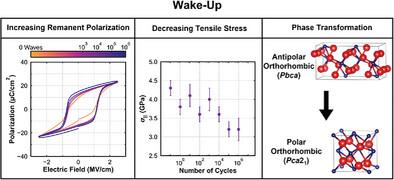当前位置:
X-MOL 学术
›
Adv. Electron. Mater.
›
论文详情
Our official English website, www.x-mol.net, welcomes your feedback! (Note: you will need to create a separate account there.)
Phase Transformations Driving Biaxial Stress Reduction During Wake‐Up of Ferroelectric Hafnium Zirconium Oxide Thin Films
Advanced Electronic Materials ( IF 5.3 ) Pub Date : 2024-06-21 , DOI: 10.1002/aelm.202400151 Samantha T. Jaszewski 1, 2 , Shelby S. Fields 1 , Sebastian Calderon 3 , Benjamin L. Aronson 1 , Thomas E. Beechem 4 , Kyle P. Kelley 5 , Casey Zhang 1 , Megan K. Lenox 1 , Ian A. Brummel 1 , Elizabeth C. Dickey 3 , Jon F. Ihlefeld 1, 6
Advanced Electronic Materials ( IF 5.3 ) Pub Date : 2024-06-21 , DOI: 10.1002/aelm.202400151 Samantha T. Jaszewski 1, 2 , Shelby S. Fields 1 , Sebastian Calderon 3 , Benjamin L. Aronson 1 , Thomas E. Beechem 4 , Kyle P. Kelley 5 , Casey Zhang 1 , Megan K. Lenox 1 , Ian A. Brummel 1 , Elizabeth C. Dickey 3 , Jon F. Ihlefeld 1, 6
Affiliation

|
Biaxial stress is identified to play an important role in the polar orthorhombic phase stability in hafnium oxide‐based ferroelectric thin films. However, the stress state during various stages of wake‐up has not yet been quantified. In this work, the stress evolution with field cycling in hafnium zirconium oxide capacitors is evaluated. The remanent polarization of a 20 nm thick hafnium zirconium oxide thin film increases from 9.80 to 15.0 µC cm−2 following 106 field cycles. This increase in remanent polarization is accompanied by a decrease in relative permittivity that indicates that a phase transformation has occurred. The presence of a phase transformation is supported by nano‐Fourier transform infrared spectroscopy measurements and scanning transmission electron microscopy that show an increase in ferroelectric phase content following wake‐up. The stress of individual devices field cycled between pristine and 106 cycles is quantified using the sin2 (ψ ) technique, and the biaxial stress is observed to decrease from 4.3 ± 0.2 to 3.2 ± 0.3 GPa. The decrease in stress is attributed, in part, to a phase transformation from the antipolar Pbca phase to the ferroelectric Pca 21 phase. This work provides new insight into the mechanisms controlling and/or accompanying polarization wake‐up in hafnium oxide‐based ferroelectrics.
中文翻译:

铁电铪锆氧化物薄膜唤醒过程中相变驱动双轴应力减少
双轴应力被认为在氧化铪基铁电薄膜的极性正交相稳定性中发挥重要作用。然而,醒来各个阶段的压力状态尚未量化。在这项工作中,评估了铪锆氧化物电容器中场循环的应力演变。经过 106 个场循环后,20 nm 厚的铪锆氧化物薄膜的剩余极化从 9.80 µC cm−2 增加到 15.0 µC cm−2。剩余极化的增加伴随着相对介电常数的降低,这表明发生了相变。纳米傅里叶变换红外光谱测量和扫描透射电子显微镜支持相变的存在,这些测量显示唤醒后铁电相含量增加。使用 sin2(ψ) 技术对在原始和 106 次循环之间进行现场循环的各个器件的应力进行量化,并且观察到双轴应力从 4.3 ± 0.2 下降到 3.2 ± 0.3 GPa。应力的降低部分归因于从反极性 Pbca 相到铁电 Pca21 相的相变。这项工作为氧化铪基铁电体中控制和/或伴随极化唤醒的机制提供了新的见解。
更新日期:2024-06-21
中文翻译:

铁电铪锆氧化物薄膜唤醒过程中相变驱动双轴应力减少
双轴应力被认为在氧化铪基铁电薄膜的极性正交相稳定性中发挥重要作用。然而,醒来各个阶段的压力状态尚未量化。在这项工作中,评估了铪锆氧化物电容器中场循环的应力演变。经过 106 个场循环后,20 nm 厚的铪锆氧化物薄膜的剩余极化从 9.80 µC cm−2 增加到 15.0 µC cm−2。剩余极化的增加伴随着相对介电常数的降低,这表明发生了相变。纳米傅里叶变换红外光谱测量和扫描透射电子显微镜支持相变的存在,这些测量显示唤醒后铁电相含量增加。使用 sin2(ψ) 技术对在原始和 106 次循环之间进行现场循环的各个器件的应力进行量化,并且观察到双轴应力从 4.3 ± 0.2 下降到 3.2 ± 0.3 GPa。应力的降低部分归因于从反极性 Pbca 相到铁电 Pca21 相的相变。这项工作为氧化铪基铁电体中控制和/或伴随极化唤醒的机制提供了新的见解。











































 京公网安备 11010802027423号
京公网安备 11010802027423号